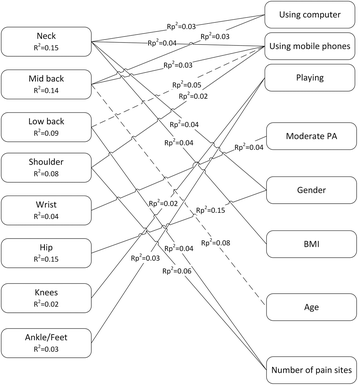Pain, pain intensity and pain disability in high school students are differently associated with physical activity, screening hours and sleep
- PMID: 28511650
- PMCID: PMC5434614
- DOI: 10.1186/s12891-017-1557-6
Pain, pain intensity and pain disability in high school students are differently associated with physical activity, screening hours and sleep
Abstract
Background: Studies exploring the association between physical activity, screen time and sleep and pain usually focus on a limited number of painful body sites. Nevertheless, pain at different body sites is likely to be of different nature. Therefore, this study aims to explore and compare the association between time spent in self-reported physical activity, in screen based activities and sleeping and i) pain presence in the last 7-days for 9 different body sites; ii) pain intensity at 9 different body sites and iii) global disability.
Methods: Nine hundred sixty nine students completed a questionnaire on pain, time spent in moderate and vigorous physical activity, screen based time watching TV/DVD, playing, using mobile phones and computers and sleeping hours. Univariate and multivariate associations between pain presence, pain intensity and disability and physical activity, screen based time and sleeping hours were investigated.
Results: Pain presence: sleeping remained in the multivariable model for the neck, mid back, wrists, knees and ankles/feet (OR 1.17 to 2.11); moderate physical activity remained in the multivariate model for the neck, shoulders, wrists, hips and ankles/feet (OR 1.06 to 1.08); vigorous physical activity remained in the multivariate model for mid back, knees and ankles/feet (OR 1.05 to 1.09) and screen time remained in the multivariate model for the low back (OR = 2.34. Pain intensity: screen time and moderate physical activity remained in the multivariable model for pain intensity at the neck, mid back, low back, shoulder, knees and ankles/feet (Rp2 0.02 to 0.04) and at the wrists (Rp2 = 0.04), respectively. Disability showed no association with sleeping, screen time or physical activity.
Conclusions: This study suggests both similarities and differences in the patterns of association between time spent in physical activity, sleeping and in screen based activities and pain presence at 8 different body sites. In addition, they also suggest that the factors associated with the presence of pain, pain intensity and pain associated disability are different.
Keywords: Disability evaluation; Pain; Physical activity; Screen time; Sleep.
Figures
Similar articles
-
Chronic pain in high school students is associated with physical activity and sleeping hours but not with screen time.Int J Adolesc Med Health. 2017 Jun 17;31(3):/j/ijamh.2019.31.issue-3/ijamh-2017-0014/ijamh-2017-0014.xml. doi: 10.1515/ijamh-2017-0014. Int J Adolesc Med Health. 2017. PMID: 28628479
-
Prevalence of low back pain in young Brazilians and associated factors: Sex, physical activity, sedentary behavior, sleep and body mass index.J Back Musculoskelet Rehabil. 2020;33(2):233-244. doi: 10.3233/BMR-170821. J Back Musculoskelet Rehabil. 2020. PMID: 31356188
-
[The use of social media modifies teenagers' sleep-related behavior].Encephale. 2018 Sep;44(4):321-328. doi: 10.1016/j.encep.2017.03.009. Epub 2017 Jun 8. Encephale. 2018. PMID: 28602529 French.
-
Back pain and school bag weight - a study on Indian children and review of literature.J Pediatr Orthop B. 2019 Jul;28(4):397-404. doi: 10.1097/BPB.0000000000000602. J Pediatr Orthop B. 2019. PMID: 30724790 Review.
-
Screen time and low back pain in children and adolescents: a systematic review of Brazilian studies.Rev Paul Pediatr. 2023 Apr 7;41:e2021342. doi: 10.1590/1984-0462/2023/41/2021342. eCollection 2023. Rev Paul Pediatr. 2023. PMID: 37042940 Free PMC article.
Cited by
-
Musculoskeletal disorders in video gamers - a systematic review.BMC Musculoskelet Disord. 2022 Jul 16;23(1):678. doi: 10.1186/s12891-022-05614-0. BMC Musculoskelet Disord. 2022. PMID: 35842605 Free PMC article.
-
Dose-response relationship between daily screen time and the risk of low back pain among children and adolescents: a meta-analysis of 57831 participants.Environ Health Prev Med. 2023;28:64. doi: 10.1265/ehpm.23-00177. Environ Health Prev Med. 2023. PMID: 37899211 Free PMC article.
-
The associations between sedentary behavior and neck pain: a systematic review and meta-analysis.BMC Public Health. 2025 Feb 4;25(1):453. doi: 10.1186/s12889-025-21685-9. BMC Public Health. 2025. PMID: 39905389 Free PMC article.
-
Predictors of pain persistence and disability in high-school students with chronic neck pain at 6-month follow-up.Qual Life Res. 2022 Mar;31(3):803-816. doi: 10.1007/s11136-021-02969-0. Epub 2021 Sep 6. Qual Life Res. 2022. PMID: 34487312
-
Increased Computer Use is Associated with Trunk Asymmetry That Negatively Impacts Health-Related Quality of Life in Early Adolescents.Patient Prefer Adherence. 2021 Oct 5;15:2289-2302. doi: 10.2147/PPA.S329635. eCollection 2021. Patient Prefer Adherence. 2021. PMID: 34675493 Free PMC article.
References
MeSH terms
LinkOut - more resources
Full Text Sources
Other Literature Sources
Medical


